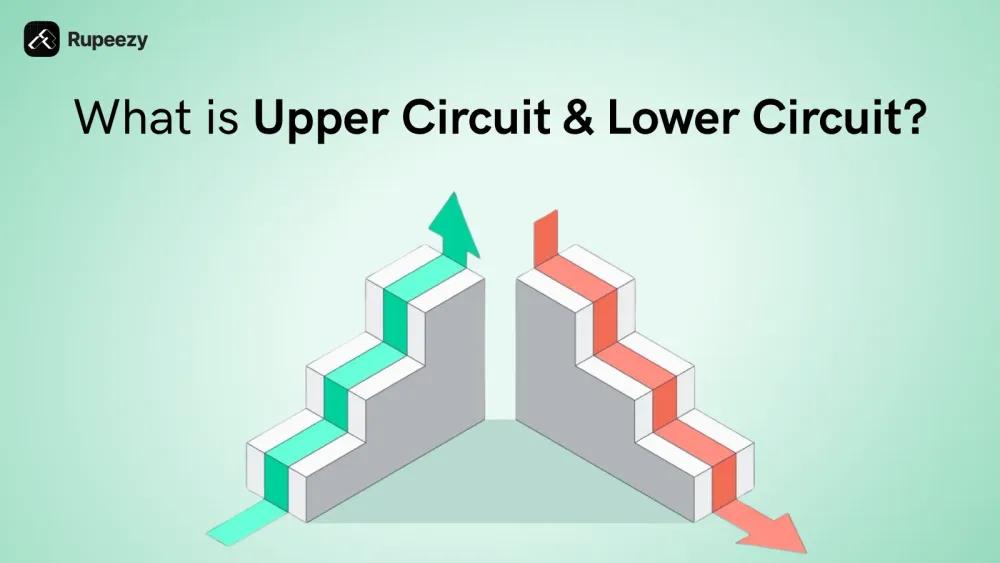What is Upper circuit and Lower Circuit in stock market?


00:00 / 00:00
It happens many times in the stock market that a stock suddenly stops rising or falling and trading stops. In such a situation, people start wondering what has happened? Actually, all this happens due to the upper circuit and lower circuit. This is a kind of volatility control mechanism, which is implemented jointly by SEBI and the stock exchange to prevent excessive volatility in the market. So let's understand, what is upper circuit and lower circuit, and why it is important for every investor to understand this.
What is Upper Circuit in Share Market?
Upper Circuit is a price level that sets the maximum limit of a stock for that day. That is, the price of a stock cannot rise more than that level in a day.
Why is it applied?
The purpose of Upper Circuit is to prevent unnecessary uptrend and trading due to FOMO (Fear of Missing Out). This gives stability to the market and protects small investors.
Example : If the current price of a stock is ?100 and there is an upper circuit of 10% on it, then its maximum price on that day can be only ?110. If it reaches ?110 and there is no one to sell it, then the stock freezes there and it is called upper circuit hit.
Important points:
After the Upper Circuit is applied, it is difficult to buy that stock because most people hold it.
Such stocks tend to rise due to trending news, good results or big deals.
Participating in pre-open or off-market orders can be a way to enter such stocks.
What is Lower Circuit in Share Market?
Lower Circuit is a level that sets the minimum fall limit of a stock on that day. That is, the stock cannot go below that limit on that day.
Why is it applied?
The main purpose of lower circuits is to prevent panic selling and artificial fall in the market. It protects investors from sudden heavy losses.
Example : If the price of a stock is ?500 and there is a lower circuit of 10% on it, then it cannot go below ?450. If there is no buyer at ?450, then the stock will stop there and it will be called lower circuit lock.
Important points :
After the lower circuit is applied, it becomes very difficult to sell the stock because there is no buyer.
Many times lower circuits are applied in penny stocks or news-driven stocks, due to which people can get trapped.
To avoid these, it is important to analyze the fundamental quality and volume of the stock.
How is the Upper/Lower Circuit Decided?
People often have a question in their mind about Upper and Lower Circuit who decides these limits and on what basis are these limits set. The simple answer is these limits are set by NSE and BSE, and they are implemented under the supervision of SEBI i.e. Securities and Exchange Board of India.
How are these limits set?
What percentage of circuit will be applied on the stock depends on these things:
Volatility i.e. how much fluctuation occurs in the stock
Liquidity i.e. how much amount of shares are bought and sold
Past Price Movement i.e. how has been the previous price behavior of that stock
Stocks which see a lot of rise or fall, a circuit of 2% or 5% is initially applied on them. On the other hand, stocks which are stable and traded more, can have a circuit limit of up to 10% or 20%.
Example:
Stock Price | 5% Upper | 10% Upper | 20% Upper |
100 | 105 | 110 | 120 |
Index-Wide Circuit Breakers
Decline | Pause in the market |
10% | Trading is halted for 45 minutes (if the decline occurs before 1 AM) |
15% | Trading closed for 1 hour |
15% | The market may be closed for the whole day |
This system was first implemented by SEBI in 2001, so that the market could be protected from major market crashes or rumours.
Why Do Circuits Exist? SEBI’s Risk Management Strategy
Circuits are necessary to prevent volatility in the market :
Sometimes the stock market suddenly rises or falls drastically - like in 2020 during the Corona period or on the news of a big scam. At such times, panic selling or buying can shake the entire market. That is why SEBI implemented Circuit Filters, so that the price of a stock or index does not go up or down more than a fixed limit.
Circuit rules have been made to protect investors :
The purpose of circuit breakers is that investors can take informed decisions without panicking. If the price of a stock crosses its limit in a day, then trading is stopped - so that decisions based on rumors and emotions can be avoided.
Helps prevent market manipulation :
According to SEBI, a major advantage of circuit rules is that it can prevent insider trading, price rigging, and artificial volatility. This maintains transparency and fairness in the market.
Circuits apply to both individual stocks and indexes :
Circuits are not limited to individual shares. If Nifty 50 or Sensex falls by 10%, 15% or 20%, index-wide circuit breakers are applied and trading in the entire market stops for some time.
SEBI has updated circuit rules over time :
After COVID-19, SEBI had reduced the circuit limits of many stocks in March 2020 to prevent unnecessary volatility. After this, when liquidity increased, they were again increased to 10% or 20%.
Can You Buy in Upper Circuit or Sell in Lower Circuit?
Buying shares in Upper Circuit and selling shares in Lower Circuit is possible as per the rules, but during trading, these orders are often not completed due to lack of liquidity and order mismatch.
How possible is it to buy stocks in the Upper Circuit?
It is technically possible to buy stocks that reach the Upper Circuit, but practically it becomes quite difficult. When the price of a stock reaches the maximum limit set for that day, most investors stop selling that stock. They hope that the price will go up further in the next trading session. In such a situation, the number of sellers in the market decreases and there is a queue of buyers. In this situation, your buy order may get stuck in a long wait because no seller is available.
How easy is it to sell stocks in the Lower Circuit?
The stock that has reached the Lower Circuit is trading at the minimum price limit of that day. In this situation, there is an atmosphere of fear in the market and buyers are almost negligible. If you want to sell such a stock, your order can be completed only when another investor is ready to buy it. But since the price is continuously falling and the stock has come down to the limit, it is difficult to find a buyer. This situation is extremely challenging for investors, especially when they are in a hurry to exit the stock.
Buying shares in Upper Circuit and selling shares in Lower Circuit can be challenging. For traders using MTF (Margin Trading Facility), circuit limits may restrict buy or sell orders, so it is important to monitor circuit levels closely to manage risk and avoid getting stuck in positions during high volatility.
How to Identify Upper Circuit Stocks?
Identifying stocks that have entered the Upper Circuit is not difficult if you use the right tools and data. These stocks are usually among the top gainers of the day and their volume suddenly increases.
To identify these stocks, you can apply filters like Top Gainers or Price Shockers on platforms like NSE India, Moneycontrol, or Screener. Apart from this, you can also identify stocks in Upper Circuit in real-time through sections like Live Market Movers, Volume Spike, and Intraday Gainers in our Rupeezy Trading App.
Keep in mind, Upper Circuit is not always a sign of good fundamentals. Sometimes it can also be just due to speculation or rumors. Therefore, before investing, definitely check the volume, news trigger and quality of the stock.
Conclusion
It is very important to understand Upper Circuit and Lower Circuit in the world of investment, because these limits protect investors during sudden rise or fall in the market. If the right data and tools are used, then stocks in the circuit can be identified in time. However, every rise or fall does not mean that the stock is fundamentally strong or weak. Therefore, before trading or investing, do analyze the quality of the stock, volume trend, and market sentiment. Only a well-thought-out decision can benefit in the long run.
FAQs
Q1. What is the upper circuit in the share market?
This is the maximum limit of a stock, up to which it can rise in a day. It is fixed to prevent abnormal rises in the stock.
Q2. What is a lower circuit in the share market?
The maximum limit of fall of a stock in a day is called lower circuit. It is made to protect investors from big losses.
Q3. Who decides upper circuit and lower circuit?
NSE and BSE decide these limits as per SEBI guidelines.
Q4. Can the upper circuit change in a day?
No, it usually does not change in a day. But it can change after review from time to time.
Q5. How to sell shares stuck in lower circuits?
You can place a limit order but the sale will not happen until a buyer is found.
The content on this blog is for educational purposes only and should not be considered investment advice. While we strive for accuracy, some information may contain errors or delays in updates.
Mentions of stocks or investment products are solely for informational purposes and do not constitute recommendations. Investors should conduct their own research before making any decisions.
Investing in financial markets are subject to market risks, and past performance does not guarantee future results. It is advisable to consult a qualified financial professional, review official documents, and verify information independently before making investment decisions.
Open Rupeezy account now. It is free and 100% secure.
Start Stock InvestmentAll Category









